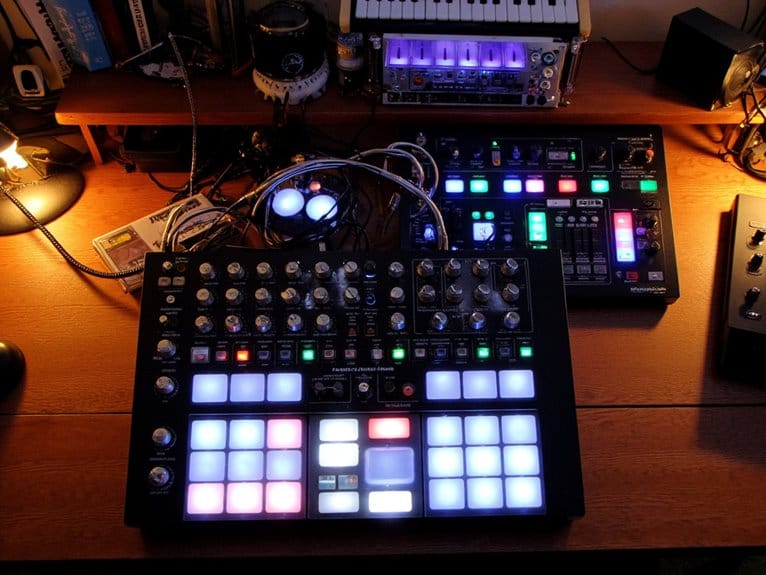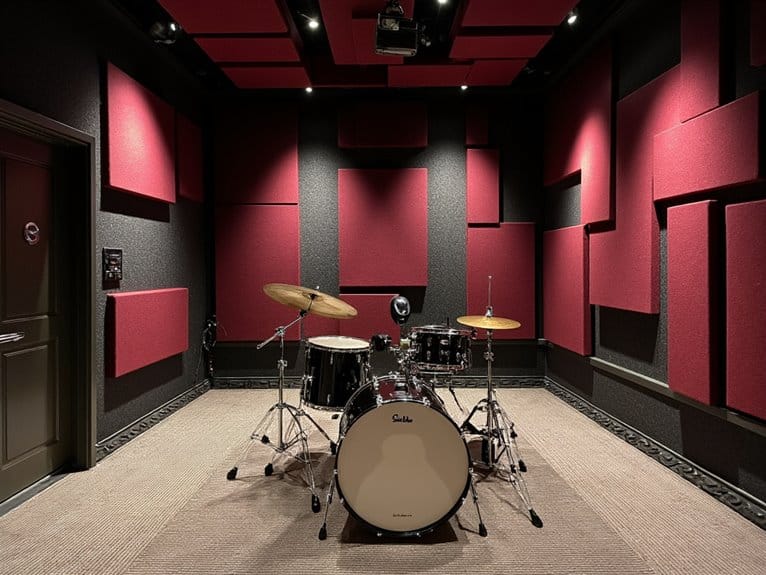Are Percussion Instruments the Oldest?
Percussion instruments have a paramount claim to being the oldest, with evidence of drumming dating back approximately 7,000 years to ancient Mesopotamia. Archaeological findings feature ceramic and stone artifacts depicting drummers, while percussion archaeology has unearthed ancient drums, rattles, and shakers. Throughout history, percussion has played a significant role in shaping cultural identities and has been utilized as a form of therapy. The use of stone tools added a percussive element to daily tasks in the Stone Age, blurring the line between tool and instrument. As we delve into the evolution of percussion, we find that the beat goes on, echoing through the ages.
We are supported by our audience. When you purchase through links on our site, we may earn an affiliate commission, at no extra cost for you. Learn more.
The Ancient Roots of Drumming
Approximately 7,000 years ago, archaeological evidence suggests that drumming originated in ancient Mesopotamia, where excavations have uncovered ceramic and stone artifacts featuring depictions of drummers. This ancient practice has evolved over time, transcending cultural boundaries to become an integral part of various societies. Drumming has not only played a significant role in shaping cultural identities but has also been utilized as a form of percussion therapy, promoting emotional expression, stress relief, and social bonding. The cultural significance of drumming is evident in its ability to bring people together, fostering a sense of community and shared experience. As we dig into the history of percussion instruments, crucial to recognize is the profound impact of drumming on human societies, both past and present.
Early Evidence of Percussion
As we dig into the evolution of percussion instruments, the earliest archaeological findings offer a glimpse into the origins of rhythmic expression, with ancient civilizations in the Middle East and Africa leaving behind a wealth of evidence that reveals the significance of percussion in their daily lives. Percussion archaeology has unearthed a rich array of artifacts, including ancient drums, rattles, and shakers, which provide valuable insights into the instrumental origins of percussion. The discovery of these ancient instruments not only sheds light on the early development of percussion but also highlights its importance in the cultural and social practices of ancient societies. By examining these early examples, we can gain a deeper understanding of the role percussion has played in shaping human experience.
Rhythms of the Stone Age
During the Paleolithic era, primitive percussion instruments crafted from stone, bone, and wood began to emerge, providing a rhythmic soundtrack to the daily lives of early humans. These early instruments likely consisted of struck stones, wooden logs, and hollow bones, which were used to create rhythmic patterns and communicate with others. Cave dwellers used these instruments to accompany rituals, ceremonies, and daily activities, such as hunting and gathering. The rhythmic sounds created by these instruments would have been an integral part of the Stone Age soundscape, helping to establish social bonds and cultural identity. The use of stone tools, for example, would have added a percussive element to daily tasks, blurring the line between tool and instrument.
Drums in Ancient Civilizations
In ancient civilizations, drums emerged as a sophisticated percussion instrument, playing a pivotal role in cultural, religious, and military contexts. Drums were used to communicate, express emotions, and convey messages. In warfare, drumming warriors utilized rhythmic patterns to intimidate enemies, coordinate attacks, and signal victories. Ceremonial beats accompanied religious rituals, festivals, and celebrations, often featuring intricate polyrhythms and complex time signatures. The use of drums in ancient civilizations highlights their significance as a primal form of expression, transcending linguistic and cultural boundaries. From Mesopotamia to ancient Egypt, Greece, and Rome, drums played a paramount role in shaping the cultural fabric of these societies, leaving an indelible mark on the evolution of percussion.
The Evolution of Percussion
With the ancient foundations of percussion laid, the Middle Ages witnessed a significant transformation in the development of percussion instruments, as various cultures adapted and refined existing technologies to create new sonic possibilities. This period saw the emergence of novel percussion techniques, such as the use of mallets and sticks, which enabled the creation of a wide range of tonal colors and textures. Instrumental diversity also flourished, with the introduction of new instruments like the tambourine, castanets, and cymbals. The fusion of Eastern and Western influences further enriched the percussion landscape, giving rise to a rich tapestry of sounds and styles that continue to plunge to this day.






